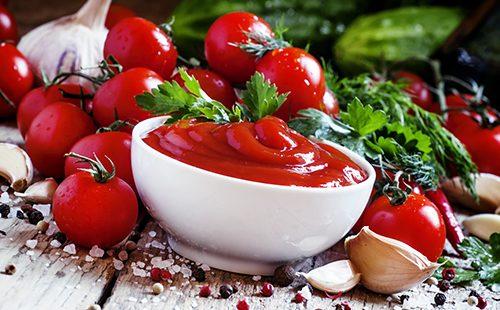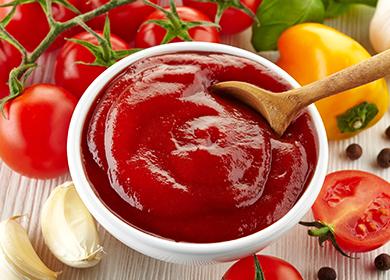Translated from Georgian “Satsebeli” - simply “sauce”, and the name is pronounced with emphasis on the first syllable. More often it is made from nuts, berries, ripe fruits. However, recipes with tomato paste or fresh meaty tomatoes, broth, garlic are no less popular.
Useful properties and calorie refills
The use of the sauce is due to its fruit and vegetable composition, supplemented with spices and spices. Nuts, grape or pomegranate juice enrich the dish with iron, magnesium, calcium, phosphorus, vitamins A, B. Onions with garlic have strong bactericidal properties, cilantro saturates with vitamin C and carotene. Tomatoes contain the enzyme lycopene, which fights cancer cells and boosts immunity.
There are other useful properties of spicy additives:
- normalization of metabolism;
- increased performance;
- prevention of vitamin deficiency;
- strengthening the walls of arteries and blood vessels;
- improved blood circulation;
- normalization of blood sugar;
- increased libido.
Cooking features
The sauce can be sour, spicy (even burning) or sweet, depending on the composition. The fruit option often contains grapes, ripe pomegranate juice, blackberries, apples or plums. Vegetable - tomatoes, hot and sweet peppers, garlic cloves, spicy greens. Spices and seasonings are added necessarily.
- Flavoring. Garlic, saffron, cilantro, coriander, tarragon, hops-suneli, peppermint, parsley add “zapashistosti” to the dressing.
- Feed temperature. They use seasoning in cold or warm form, but not hot.
- Harvesting for future use. For winter storage, the mass is boiled, laid out on sterilized jars, pouring a little vinegar before this, twist.
- Product Preparation. Peppers are free from seeds, white partitions, plums, cherry plum - from the seeds. Peel the tomatoes after scalding. The greens are washed and dried, the onions and garlic are peeled.
Satsebeli sauce: basic recipe
Features. The easiest tsibibeli sauce recipe that everyone will like. Even an inexperienced housewife will be able to cook traditional satsebel from tomatoes and bell pepper - there are no difficulties in the recipe. The taste is regulated with the help of chili and garlic, other hot seasonings. Such an additive is served in warm or cold form to barbecue, lamb, khinkali, chakhokhbili, hodgepodge. It goes well with pickled cheeses, grilled vegetables, kharcho soup, rice and even pies.
What to prepare:
- ripe, even overripe tomatoes - 2.4 kg;
- bell peppers - 0.6 kg;
- hot chili - one pod;
- garlic - a large head;
- coriander - a third of a teaspoon;
- dill - five to six branches;
- cilantro - five to six branches;
- ground red hot pepper - a pinch;
- salt - one tablespoon.
How to do
- Cut the ripe tomatoes into two or four parts, removing the skins from them, remove for an hour or two in the refrigerator.
- Drain the juice.
- Cut peeled peppers into quarters, boil in boiling water for ten minutes.Cool, remove thin skin from slices.
- Pour tomatoes into the water, cook for ten minutes.
- Rub chilled vegetables through a sieve. Add spices, ground hot pepper.
- Cook the vegetable puree over medium heat for 15 minutes to evaporate the excess liquid.
- Then simmer over low heat for about an hour.
- Add chopped herbs, crushed garlic in a mortar or garlic squeezer, remove after five minutes from the stove.
- Pour the thickened mass into sterilized jars, bottles, roll up.
Original seasonings
There are many unusual options for spicy sauce. Spicy satsebel is prepared in different hostesses on the basis of grapes, pomegranate juice, cherry plum, with chicken broth and walnuts. Often added garlic, onions, hot chili peppers. Such a spicy additive is served to various dishes of chicken, meat, fish, vegetables and cereals.
From plums
Features. The recipe for Satsebeli sauce from plums in Georgia is usually passed on from generation to generation. The walnuts and condiments contained in the composition go well with garlic, juicy and sweet fruits. Seasoning is used both in warm and in hot form.
What to prepare:
- plums - 1 kg;
- sugar - 100 g;
- peeled walnuts - 120 g;
- garlic - 50 g;
- salt - 15 g;
- chili pepper - 30 g;
- ground pepper - 5 g;
- curry seasoning - 10 g.
How to do
- Grind chili, seedless plums, nuts and garlic cloves with a meat grinder, scrolling twice.
- Place the fruit-nut mixture in a thick-bottomed pan, salt, sweeten, and add spices.
- Boil, then boil for half an hour, stirring the mass.
- Pour the sauce into sterilized wide-necked bottles, preserve.
From cherry plum
Features. The recipe for Satsebeli from cherry plum is delicious and fragrant. Many housewives and family members after tasting will forever become his fans. Usually it is served with a lamb or pork shish kebab, rice, spaghetti, khachapuri, even warm lavash.
What to prepare:
- cherry plum - 1 kg;
- cilantro - 50 g;
- dill - 50 g;
- sugar - 60 g;
- garlic - three cloves;
- dried chilli peppers - a quarter of a red pod;
- salt.
How to do
- Pour boiling water over cherry plum, wait five minutes. Drain the water, rub the fruit through a large sieve to a puree condition.
- Transfer the fruit mass to a pan with a thick bottom, put on fire.
- Add chopped greens and crushed garlic, cook the remaining ingredients for a quarter of an hour, stirring occasionally.
- Sterilize the jars in the oven or steamed, pour over the lids with boiling water.
- Lay out the hot mass in containers, tighten.
- Wrap until cool by placing on the lids.
With walnuts as in the photo
Features. With walnuts and broth, Satsebeli sauce is much more satisfying than just with vegetables and fruits. Many people like this recipe because of its thick consistency, pungent taste, spicy aroma of cilantro and refreshing mint. Serving for meat, poultry dishes, soups.
What to prepare:
- peeled walnuts - 200 g;
- garlic - five to six cloves;
- onion - one;
- green cilantro - ten branches;
- peppermint greens - five branches;
- ground red pepper - to taste;
- chicken broth - 200-300 ml;
- table vinegar - one teaspoon;
- salt - one teaspoon.
How to do
- Chopped peeled onions and garlic.
- Grind greens with a knife.
- Mix the ingredients in the dish, add walnuts, grind with a blender.
- Pepper, salt, dilute with vinegar and cooled chicken stock to the desired consistency.

With tomato paste
Features. Georgian satsebeli with tomato paste, adjika and garlic is distinguished by its sharpness, mouth-watering color and smell. The sauce is prepared thick, but if desired, it is easily diluted with boiled water to the desired consistency.
What to prepare:
- tomato paste - 150 g;
- green cilantro - ten branches;
- garlic - three cloves;
- boiled water (cold) - 150 ml;
- hops-suneli - one teaspoon;
- adjika - one teaspoon;
- apple cider vinegar - two tablespoons;
- salt.
How to do
- Rinse garlic, crush with a press.
- Chopped dried greens after washing.
- Mix both ingredients with adjika, suneli hops, beat with a blender until smooth.
- Add the paste and apple cider vinegar, mix.
- Pour in water while stirring to get the desired density of the sauce.
- To salt.
With pomegranate
Features. Georgian fruit Satsebeli sauce with pomegranate juice is dark pink, aromatic, delicious. It is usually served with pasta, poultry, fish, kebabs and baked meat. The density of the dressing is regulated by adding or reducing the amount of pomegranate juice during cooking.
What to prepare:
- large pomegranate - one;
- peeled and roasted walnuts - 150 g;
- coriander greens - ten stems;
- hot ground red pepper;
- salt.
How to do
- Peel the ripe pomegranate from the skin, wrap with gauze folded in several layers.
- Twist the gauze “bag” tightly, squeeze pomegranate juice into a bowl. It is advisable to squeeze about 180-200 ml.
- Chop the coriander greens, mix with the fried walnuts.
- Grind in a mortar and pestle until you get aromatic slurry, add salt and pepper.
- Pour pomegranate juice in a dose (30-40 ml at a time), stirring until a uniform, thick dressing is obtained.
With grapes
Features. Satsebeli grape sauce at home is easy to prepare. It turns out not too thick, tasty and fragrant, it goes well with meat dishes. In sterilized jars under iron covers seasoning is stored all winter.
What to prepare:
- meaty tomatoes - 7 kg;
- red bell pepper - 1.5 kg;
- seedless green grapes - 1.5 kg;
- hot red chili - one pod;
- garlic - three middle heads;
- cilantro - four large bunches;
- ground pepper - a pinch (as much as possible);
- salt - one and a half teaspoons.
How to do
- Skip the prepared vegetables and grapes without seeds two or three times through a meat grinder, so that there are fewer pieces, transfer to a large thick-bottomed pan.
- Boil, cook over low heat for 40 minutes. Stir with a spatula so as not to stick.
- Grind the slightly cooled mass through a sieve or a blender.
- Remove the cake, pour the sauce back into the pan.
- Cook until thick (about two hours).
- 15 minutes before the end of cooking, add salt, crushed garlic, crushed cilantro.
- Arrange on sterilized jars, tighten.

Harvesting for the winter
Features. If you want to enjoy a delicious dressing of fresh vegetables even in cold weather, you can preserve the aromatic additive. Satsebeli sauce is prepared for the winter from tomatoes and peppers with the addition of fresh herbs. Hot mass is bottled only in dried, pre-sterilized banks of any volume.
What to prepare:
- red tomatoes - 3 kg;
- bell peppers - 1 kg;
- hot chili - one pod;
- garlic - one head;
- parsley - ten branches;
- dill - ten branches;
- cilantro - ten branches;
- ground coriander - one large spoon;
- sugar and salt to taste.
How to do
- Grind the garlic, set aside for a while, closing the bowl with a lid.
- Scroll vegetables and dried herbs through a meat grinder.
- Transfer the mixture to a pan, boil, keep on fire for 20 minutes, waiting for thickening.
- Pour in coriander, and after 15 minutes add garlic gruel, salt and sugar.
- Boil, turn off the fire, arrange in glass containers.
- Turn over at night, cover.
Preparing the satsebeli sauce according to any of the above recipes is easy, having prepared products, jars and kitchen utensils in advance. Store the finished dressing in room conditions in sealed glass containers for no more than three to five days. Putting cans in the refrigerator or cellar will help increase the shelf life to three to four weeks.
Other homemade recipes
Transparent Ranetka Jam
Classic recipe
Microwave Sterilizing Cans
Sterilizing cans in the oven

